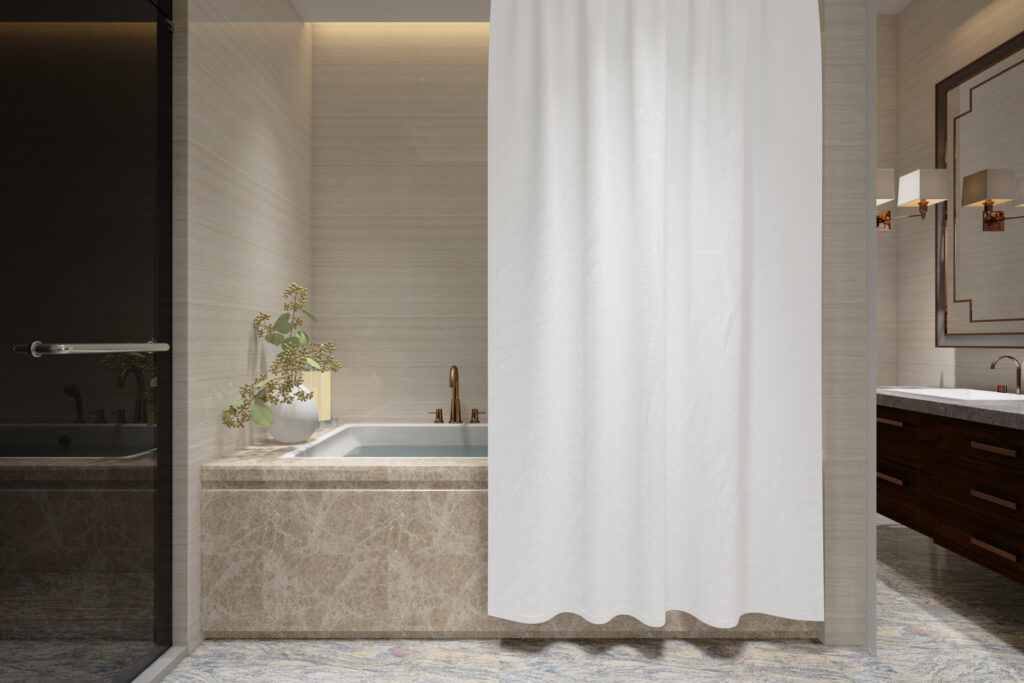The Shower Curtain: A Splash of Functionality and Style
The shower curtain – that often-overlooked bathroom essential that serves as both a practical barrier and a potential design statement. While it may seem like a simple piece of fabric or plastic, using a shower curtain properly can make a significant difference in your daily shower routine. In this article, we’ll dive into the world of shower curtains, exploring their proper use and how they can enhance your bathroom experience.

Choosing the Right Shower Curtain
Before we delve into the proper use of a shower curtain, let’s talk about selecting the right one for your bathroom. Shower curtains come in a wide variety of materials, styles, and colors, so you have the opportunity to showcase your personality and match your bathroom decor. Here are a few considerations:
- Material: The most common materials for shower curtains are vinyl, polyester, cotton, and nylon. Vinyl and polyester curtains are excellent choices for their water-repellent properties, while cotton and nylon add a touch of luxury but may require a liner.
- Length: Ensure your shower curtain is the right length to cover your shower or bathtub completely. It should hang a few inches below the edge of the tub to prevent water from escaping onto the floor.
- Style: Choose a style that complements your bathroom decor, whether it’s a simple solid color, a playful pattern, or a serene nature-inspired design.

Proper Installation
Once you’ve found the perfect shower curtain, it’s time to install it correctly. Proper installation ensures that your shower curtain functions effectively in keeping water within the shower area.
- Use a Shower Curtain Liner: For extra protection against water leakage, it’s a good idea to use a shower curtain liner along with your decorative curtain. Liners are typically made of water-repellent materials and can be easily replaced when needed.
- Invest in Quality Hooks or Rings: Use durable hooks or rings to attach your curtain to the shower rod. These should slide smoothly and securely hold the curtain in place.
- Position the Curtain Rod: The curtain rod should be installed above the shower or bathtub at a height that allows the curtain to drape down inside the tub. Make sure it’s securely fastened to the walls.
- Allow Some Overlap: When closing the curtain, make sure there is a slight overlap between the two sides to prevent water from escaping through any gaps.

Maintaining Your Shower Curtain
Proper maintenance is essential to prolong the life of your shower curtain and keep it looking fresh and clean.
- Regular Cleaning: Over time, your shower curtain may develop soap scum, mold, or mildew. It’s a good practice to clean it regularly to prevent these issues. Vinyl and polyester curtains can often be wiped clean, while fabric curtains may be machine-washed or spot-cleaned as per the care instructions.
- Air Circulation: After showering, leave the shower curtain partially open to allow air circulation, which helps prevent the growth of mold and mildew.
- Replace When Necessary: If your shower curtain becomes discolored, torn, or shows signs of mold that can’t be removed, it’s time to replace it. A new curtain can instantly refresh the look of your bathroom.

In the grand scheme of bathroom accessories, the shower curtain plays a pivotal role in maintaining a dry, clean, and stylish environment. By choosing the right curtain, installing it properly, and keeping up with maintenance, you can ensure that this humble addition to your bathroom not only serves its practical purpose but also adds a touch of personality and elegance to your daily shower routine. So, don’t underestimate the power of the shower curtain – it’s more than just a piece of fabric; it’s an essential part of your bathroom oasis.
